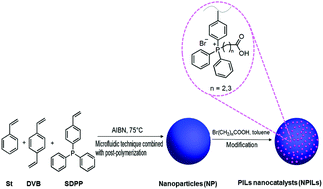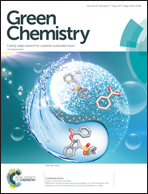Controllable preparation of phosphonium-based polymeric ionic liquids as highly selective nanocatalysts for the chemical conversion of CO2 with epoxides†
Abstract
Phosphonium-based polymeric ionic liquids (PILs) have been prepared in a controlled way by using a microfluidic technique within an improved membrane microdevice. Using this method, the average diameter sizes of the particles could be tuned from 6.4 to 375 nm through varying the dispersed phase flow rates from 1.0 to 7.0 mL min−1. The nanoparticles were characterized by FTIR, SEM, HRTEM, EDS, TGA and ICP, and their catalytic properties were estimated in the cycloaddition of CO2 with epoxides. It was found they could deliver good to excellent yields with selectivities of more than 99%. 1-Bromoacrylic acid-decorated nanoparticles (NPILs-BPA) were especially effective. Additionally, the activity displayed obvious size-dependence, increasing for the smaller particles, and the particles were stable when recycled seven times, retaining their catalytic activity and selectivity. Meanwhile, the ability of NPILs-BPA to provide carboxylic acid groups and act as a hydrogen bonding donor to activate the ring-opening of epoxides was tested by in situ FTIR. This work provides a continuous, simple method for the preparation of PILs with controlled nanosizes, and offers the potential for scale-up and throughput in industrial applications.



 Please wait while we load your content...
Please wait while we load your content...